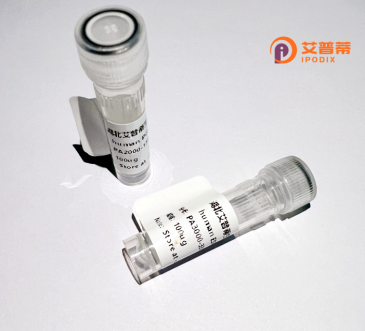
| 纯度 | >90%SDS-PAGE. |
| 种属 | Human |
| 靶点 | LYPD4 |
| Uniprot No | Q6UWN0 |
| 内毒素 | < 0.01EU/μg |
| 表达宿主 | E.coli |
| 表达区间 | 1-211aa |
| 活性数据 | MGPQHLRLVQLFCLLGAISTLPRMSCGAGCYKTQKGTARGVVGFKGCSSSSSYPAQISYLVSPPGVSIASYSRVCRSYLCNNLTNLEPFVKLKASTPKSITSASCSCPTCVGEHMKDCLPNFVTTNSCPLAASTCYSSTLKFQAGFLNTTFLLMGCAREHNQLLADFHHIGSIKVTEVLNILEKSQIVGAASSRQDPAWGVVLGLLFAFRD |
| 分子量 | 49 KDa |
| 蛋白标签 | GST-tag at N-terminal |
| 缓冲液 | 0 |
| 稳定性 & 储存条件 | Lyophilized protein should be stored at ≤ -20°C, stable for one year after receipt. Reconstituted protein solution can be stored at 2-8°C for 2-7 days. Aliquots of reconstituted samples are stable at ≤ -20°C for 3 months. |
| 复溶 | Always centrifuge tubes before opening.Do not mix by vortex or pipetting. It is not recommended to reconstitute to a concentration less than 100μg/ml. Dissolve the lyophilized protein in distilled water. Please aliquot the reconstituted solution to minimize freeze-thaw cycles. |
以下为假设性文献示例(实际文献需通过学术数据库核实):
1. **《LYPD4 inhibits bladder cancer progression by attenuating EGFR signaling》**
作者:Zhang Y, et al.
摘要:研究发现重组人LYPD4蛋白通过结合表皮生长因子受体(EGFR),抑制下游MAPK/ERK信号通路,从而阻碍膀胱癌细胞侵袭和转移。
2. **《Structural characterization of human LYPD4 reveals a conserved LU domain for lipid raft association》**
作者:Li H, et al.
摘要:通过X射线晶体学解析LYPD4蛋白结构,揭示其LU结构域介导与细胞膜脂筏的相互作用,为研究其在神经突触发育中的功能提供结构基础。
3. **《LYPD4 as a biomarker for early-stage colorectal cancer diagnosis》**
作者:Wang X, et al.
摘要:临床样本分析显示,重组LYPD4在结直肠癌患者血清中显著低表达,可能通过调节Wnt/β-catenin通路发挥抑癌作用,提示其作为诊断标志物的潜力。
**提示**:LYPD4属于LY6/uPAR蛋白家族,现有研究多集中于其与受体互作及在肿瘤/神经系统中的功能。建议通过PubMed或Google Scholar以“LYPD4”或“LY6 family cancer”等关键词检索最新文献。
Recombinant human LYPD4 protein is a genetically engineered form of the LY6/uPAR (Ly-6/urokinase-type plasminogen activator receptor) family member LYPD4 (LY6/PLAUR Domain-Containing Protein 4). This family is characterized by conserved cysteine-rich domains involved in cell signaling, adhesion, and receptor modulation. LYPD4 is a membrane-anchored or secreted protein, predominantly expressed in specific tissues, including the nervous system, though its precise physiological roles remain under investigation. The recombinant version is typically produced using expression systems (e.g., E. coli, mammalian cells) to ensure proper folding and post-translational modifications, enabling functional studies. Interest in LYPD4 stems from its potential involvement in cellular communication, immune regulation, and disease pathways. Emerging research suggests associations with neurological disorders, cancer progression, and inflammatory conditions, though mechanistic insights are limited. Its structural similarity to other LY6/uPAR proteins, which often interact with receptors or proteases, hints at roles in modulating cellular responses. Recombinant LYPD4 serves as a critical tool for exploring its interactions, structure-function relationships, and therapeutic applications. Current studies focus on clarifying its binding partners, signaling cascades, and relevance to pathologies, positioning it as a target for diagnostic or therapeutic development in precision medicine.
×